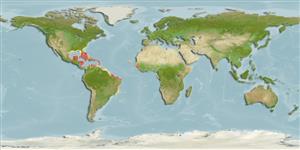Environment: milieu / climate zone / depth range / distribution range
นิเวศวิทยา
เกี่ยวกับทะเล,น้ำเค็ม เกี่ยวกับหินโสโครก; ระดับความลึก 0 - 40 m (Ref. 13121), usually 0 - 3 m (Ref. 9710). Subtropical; 32°N - 26°S, 100°W - 32°W
Southwestern Atlantic: from Bahamas and Florida southwards to Brazil.
ขนาด / น้ำหนัก / Age
Maturity: Lm ? range ? - ? cm
Max length : 7.5 cm TL เพศผู้/กระเทย; (Ref. 13628)
เงี่ยงครีบหลัง (รวม) : 20 - 21; ก้านครีบอ่อนที่หาง (รวม) : 11 - 12; เงี่ยงครีบก้น: 2; ก้านครีบอ่อนที่ก้น: 20 - 22. With 3-5 dark brownish-red bands in form of inverted triangles along side. No other labrisomid has this distinctive color pattern (Ref. 26938). Head with a few small dark spots; bars on body sometimes not very dark but outlined by dark bars; scattered dots then often present elsewhere on the body (Ref. 13442).
Inhabits coral reefs and rocky shores. Often found in crevices, or among weed and rubble (Ref. 13121). Feeds on crustaceans (Ref. 13628).
Life cycle and mating behavior
Maturities | การสืบพันธุ์ | Spawnings | Egg(s) | Fecundities | ตัวอ่อน
Robins, C.R. and G.C. Ray, 1986. A field guide to Atlantic coast fishes of North America. Houghton Mifflin Company, Boston, U.S.A. 354 p. (Ref. 7251)
IUCN Red List Status (Ref. 130435)
Threat to humans
Harmless
Human uses
การประมง: การค้า; สถานที่แสดงสัตว์และพืชน้ำ: การค้า
เครื่องมือ
Special reports
Download XML
แหล่งที่มาจากอินเตอร์เน็ต
Estimates based on models
Preferred temperature (Ref.
123201): 26.3 - 28.2, mean 27.5 °C (based on 645 cells).
Phylogenetic diversity index (Ref.
82804): PD
50 = 0.5000 [Uniqueness, from 0.5 = low to 2.0 = high].
Bayesian length-weight: a=0.00912 (0.00399 - 0.02083), b=3.06 (2.87 - 3.25), in cm total length, based on LWR estimates for this (Sub)family-body shape (Ref.
93245).
ระดับชั้นอาหาร (Ref.
69278): 3.5 ±0.50 se; based on food items.
Fishing Vulnerability (Ref.
59153): Low vulnerability (10 of 100).
Nutrients (Ref.
124155): Calcium = 75.4 [33.0, 164.9] mg/100g; Iron = 0.804 [0.436, 1.431] mg/100g; Protein = 19.4 [18.3, 20.5] %; Omega3 = 0.263 [0.143, 0.481] g/100g; Selenium = 10.5 [4.3, 22.4] μg/100g; VitaminA = 124 [37, 429] μg/100g; Zinc = 1.45 [0.88, 2.25] mg/100g (wet weight);
